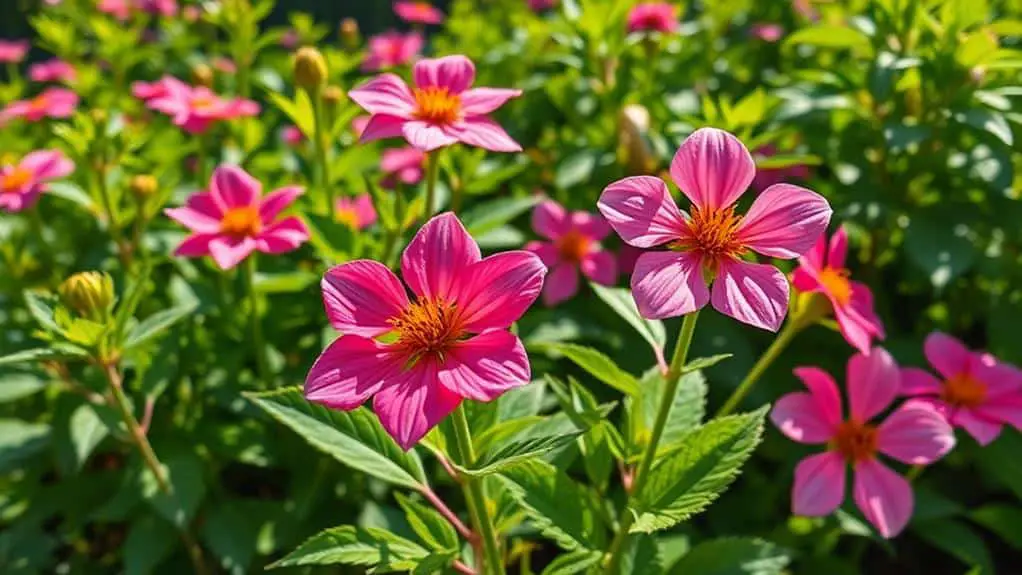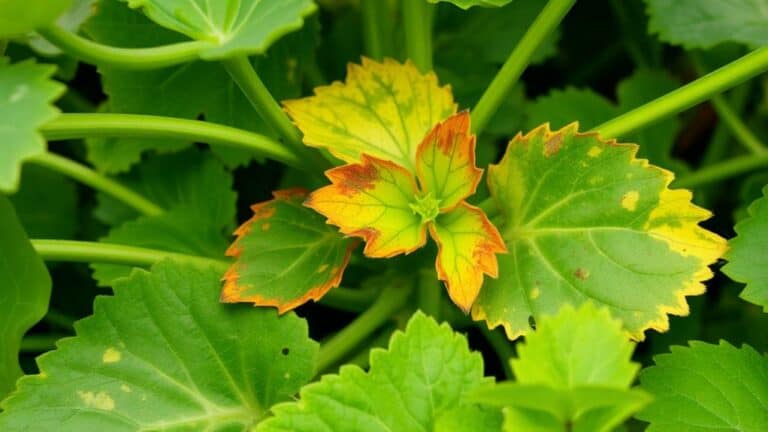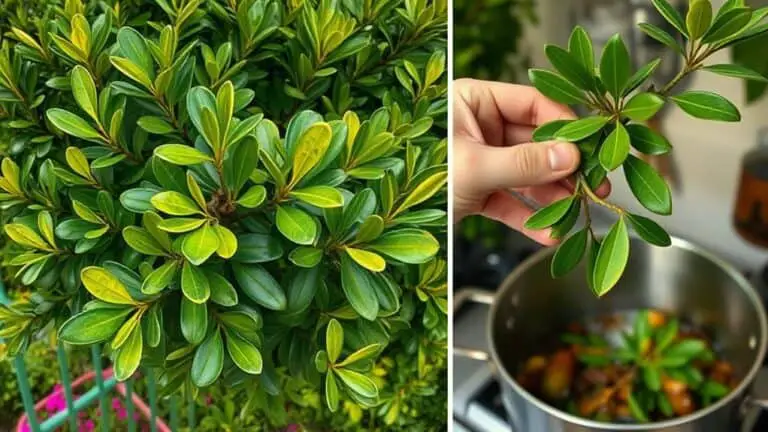Tips To Create Long Lasting Blooms On Pentas Flowers
When it comes to nurturing pentas flowers for those vibrant, long-lasting blooms, I've found that a few key practices make all the difference. Ensuring they receive ample sunlight, at least six hours daily, is essential for enhancing their color and vigor. But it's not just about sunlight; how you water them and the type of soil you use play significant roles too. Consistently moist, well-drained soil helps prevent issues like root rot. And don't forget to deadhead spent blooms regularly. Curious about the best fertilization schedule and how to keep pests at bay? Let's explore these strategies for thriving pentas.
Understanding Pentas Flowers
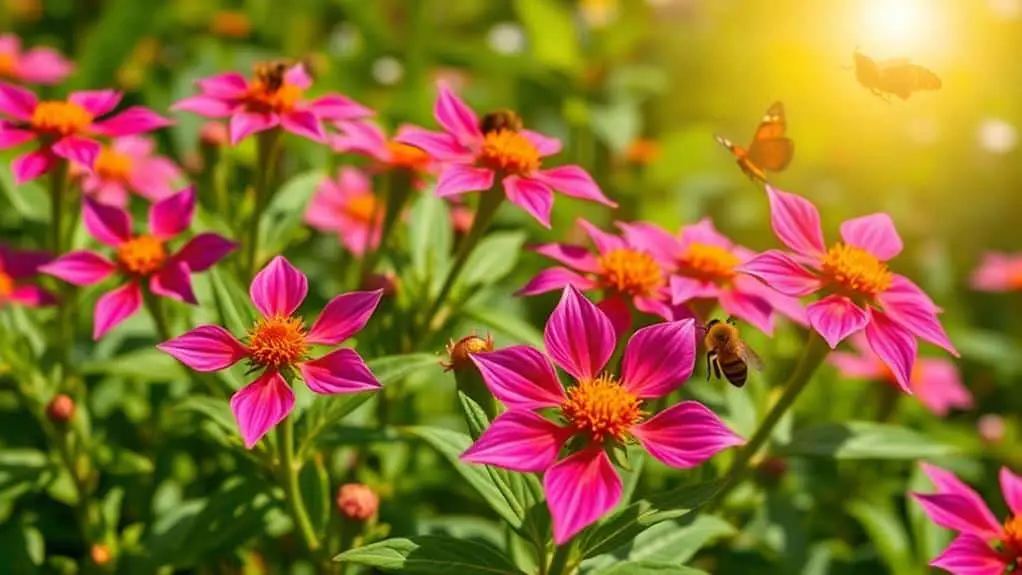
Several key aspects can help you understand pentas flowers better. Pentas, also called Egyptian star clusters, are native to Eastern Africa and the Arabian Peninsula. They thrive in USDA hardiness zones 10 to 11, reaching a mature size of 2 to 3 feet wide.
The star-shaped blooms come in striking colors like pink, red, white, purple, and lavender. These vibrant flowers attract pollinators such as hummingbirds and butterflies.
For ideal blooms, pentas need well-drained, consistently moist soil. They're low-maintenance and fairly drought-tolerant once established.
An essential part of pentas care is regular deadheading. Removing spent flowers encourages more blooms since pentas don't self-clean.
With these tips, you'll find caring for pentas both easy and rewarding.
Sunlight Requirements
To keep your pentas flowers blooming beautifully, they need plenty of sunlight.
Aim for at least six hours of direct sun each day to guarantee they stay healthy and vibrant.
If you want the best results, find the sunniest spot in your garden and watch your pentas thrive.
Full Sun Benefits
For the best blooms, pentas flowers need a generous dose of full sun. This means they thrive when they receive at least six hours of direct sunlight each day, which is essential for ideal blooming.
Full sun enhances their vibrant colors, making them irresistible to pollinators like hummingbirds and butterflies. Plus, plants basking in full sun are generally more robust and bushier, leading to increased flower production throughout the blooming season.
Without enough sunlight, pentas can become leggy and produce fewer blooms, reducing their visual appeal. Additionally, full sun conditions help prevent fungal diseases by promoting better air circulation around the plants.
Minimum Sun Hours
When growing pentas flowers, ensuring they get the right amount of sunlight is critical. To care for pentas properly, you'll need to provide a minimum of 6 hours of direct sunlight each day.
Ideally, aim for bright light conditions with at least 8 hours of sun, especially in cooler climates. Insufficient sunlight won't do your pentas any favors, leading to leggy growth and fewer blooms.
Consider these quick tips:
- Full sun: Aim for areas with uninterrupted sunlight.
- Positioning: Place them in spots that catch the morning sun.
- Partial shade: If necessary, make sure they still get bright light.
Ensuring adequate sunlight promotes not only abundant blooms but also the overall health and resilience of your pentas.
Bloom Optimization Tips
Ensuring your pentas flowers get the right amount of sunlight is key to maximizing their blooming potential. One of the essential bloom optimization tips is providing full sun exposure.
Pentas need at least 6 to 8 hours of direct sunlight daily. If they don't get enough light, they might grow leggy and produce fewer flowers. So, place them in well-lit areas, avoiding shaded spots. During the growing season, make sure they get consistent sunlight.
Plant them in spring after the last frost to help them establish. Also, consider using reflective mulches or light-colored surfaces nearby to boost light availability.
Pair this with well-drained soil, and your pentas will reward you with vibrant, long-lasting blooms.
Proper Watering Techniques
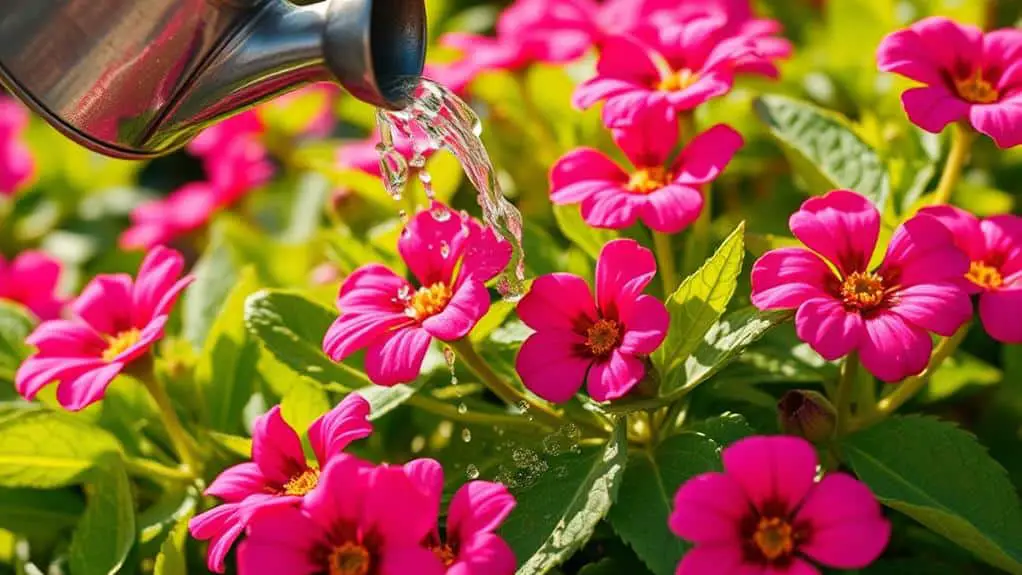
When it comes to keeping your Pentas flowers healthy, proper watering is key.
Water them regularly to keep the soil moist but not soggy, as too much water can cause root rot.
Check the soil moisture and watch for yellow leaves, which might mean you're overdoing it.
Ideal Watering Frequency
Proper watering is essential for keeping your Pentas flowers vibrant and healthy. To achieve this, you need to pay attention to the soil, watering frequency, and mulching.
Here are some tips:
- Water regularly: Pentas prefer consistently moist soil. During dry spells, make sure to water them more often.
- Avoid overwatering: Check the soil to ascertain it's not soggy. Overwatering can lead to root rot and fungal diseases.
- Use mulch: Applying mulch around your plants helps retain soil moisture, reducing the frequency of watering required.
Soil Moisture Monitoring
Monitoring soil moisture is the next step to guarantee your Pentas flowers thrive.
To keep your soil in perfect shape, you'll need to make sure it stays consistently moist but not soggy. Overwatering can lead to root rot, which is something we definitely want to avoid.
During dry spells, water deeply so the soil is moist 1 to 2 inches down. Adjust based on rainfall and temperature.
Mulch around the base of your plants to help retain moisture and reduce evaporation.
Watch for wilting leaves or dry soil—they're signs you need to water more. Let the top inch of soil dry out between watering sessions to prevent waterlogging and support healthy roots.
Keep an eye on that soil moisture!
Avoiding Root Rot
To keep root rot at bay, it's crucial to guarantee your Pentas flowers are planted in well-drained soil. This helps them thrive in moist but not soggy conditions.
You'll need to water regularly, especially in dry spells, but be cautious not to overwater. Adjust your watering based on rainfall and always check soil moisture frequently. If the top inch of soil is dry, it's time to water, but avoid soaking it.
Here are some tips:
- Use mulch to retain moisture and reduce watering frequency.
- Watch for yellowing leaves, a sign of overwatering.
- Confirm soil is loose to prevent compaction.
Ideal Soil Conditions
For pentas flowers to truly thrive, the right soil conditions are key. You'll need well-drained soil to prevent root rot. Sandy loam or a quality potting mix works best. Aim for a neutral pH range of 6.0 to 7.0, which guarantees that nutrients are available to your plants.
Incorporating organic matter into the soil can enhance moisture retention while still allowing proper drainage. Heavy clay soils are a no-go because they retain too much water and can lead to fungal diseases.
Regularly check your soil for signs of nutrient deficiencies, as enriched conditions help pentas produce vibrant blooms. By paying attention to these ideal soil conditions, you'll set your pentas up for success.
Fertilization Schedule
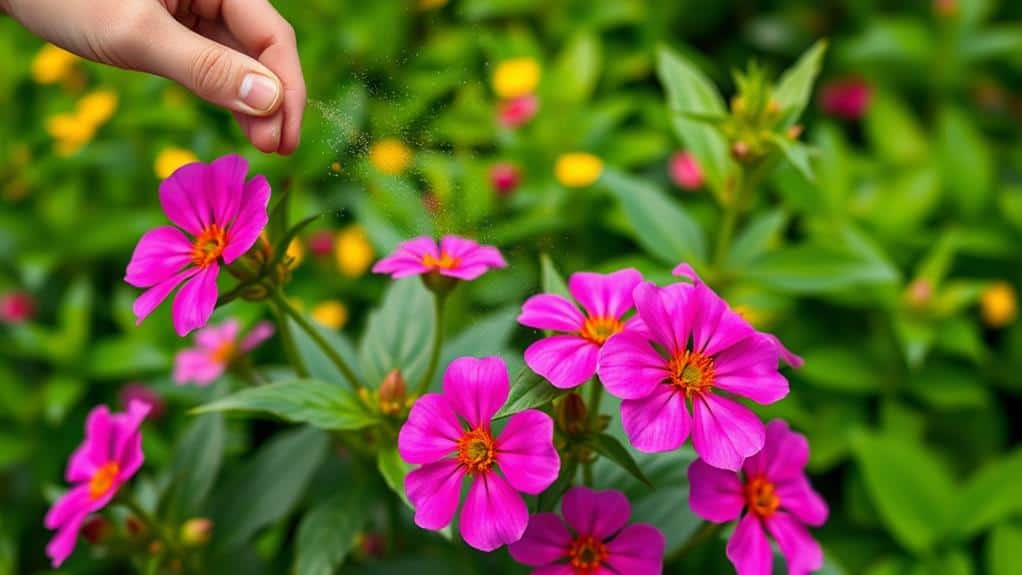
To keep your Pentas flowers blooming beautifully, you'll need to stick to a good fertilization schedule.
I recommend applying a balanced liquid fertilizer every 4 to 6 weeks during the growing season.
This routine will support healthy growth and guarantee your plants produce plenty of vibrant blooms.
Balanced Liquid Fertilizer
Applying a balanced liquid fertilizer every 4 to 6 weeks during the growing season is key to keeping your pentas flowers blooming beautifully. This helps promote ideal blooming by providing the essential nutrients your plants need.
To guarantee the best results, follow these tips:
- Use a water-soluble fertilizer to encourage vibrant flower production.
- Enrich the soil with organic matter to enhance nutrient absorption.
- Watch for signs of overfertilization, like white crusty buildup, to prevent root burn.
Application Frequency
Maintaining a consistent fertilization schedule is essential for ensuring your pentas flowers thrive. During the growing season, I apply a balanced liquid fertilizer every 4 to 6 weeks to promote healthy growth and vibrant blooms. At the beginning of the season, I use a slow-release granular fertilizer to provide sustained nutrients. This helps the plants flourish throughout the blooming period.
I always monitor for signs of overfertilization, like a white crusty buildup on the soil. To enrich the soil and enhance nutrient absorption, I mix in organic matter. Adjusting the fertilization frequency based on the plant's health is key—healthier plants might need less frequent feeding.
| Fertilizer Type | Application Time |
|---|---|
| Liquid Fertilizer | Every 4-6 weeks |
| Granular Fertilizer | Beginning of season |
| Organic Matter | Throughout season |
This schedule keeps my pentas looking their best!
Deadheading and Pruning
Regular deadheading and pruning are essential for keeping your pentas flowers vibrant and healthy.
Deadheading involves removing spent blooms to encourage continuous flowering. Use sharp, sanitized shears to cut below wilted flowers and above the foliage.
Pruning, on the other hand, helps improve air circulation and encourages bushier growth.
- Deadheading: Manually remove spent blooms as pentas don't self-clean.
- Pruning: Trim in late winter or early spring to remove dead stems.
- Tools: Always use sharp, clean shears to minimize plant damage.
Taking these steps guarantees your pentas will flourish.
By deadheading regularly and pruning thoughtfully, you'll enjoy a garden full of vibrant, healthy blooms all season long.
Don't worry, you've got this!
Seasonal Maintenance
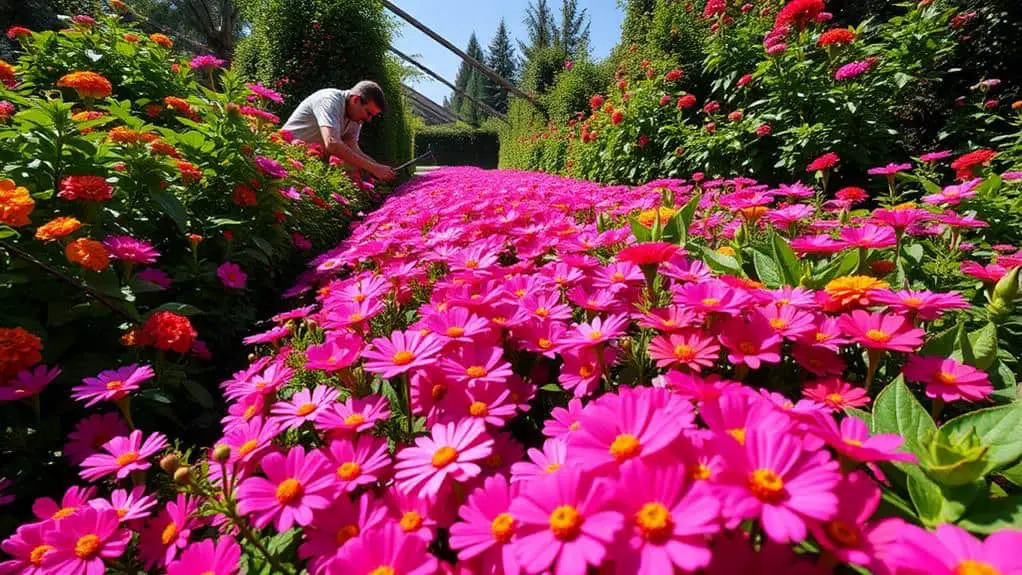
When it comes to keeping your pentas flowers thriving throughout the year, seasonal maintenance is key. Regular deadheading of spent blooms encourages new growth and continuous blooming.
I recommend pruning in late winter or early spring to boost bushiness and improve air circulation. This leads to healthier plants with more flowers.
Consistently applying a balanced liquid fertilizer every 4 to 6 weeks supports nutrient uptake, which is essential for long-lasting blooms.
Also, keep an eye on soil moisture levels. Watering regularly, especially during dry spells, helps prevent plant stress.
Mulching around your pentas can retain moisture and suppress weeds.
Overwintering Pentas
As we move from seasonal maintenance to the specific needs of overwintering pentas, it's important to prepare these vibrant plants for the colder months ahead.
Here's what you need to do:
- Bring containerized pentas indoors before the first frost and place them in a sunny spot.
- Monitor indoor pentas for any signs of pests or diseases, as they can be more susceptible indoors.
- Regularly check soil moisture to keep it consistently moist but not soggy.
If your pentas are planted in the ground, take softwood cuttings in early spring to propagate new plants indoors.
When spring arrives, gradually acclimate pentas to outdoor conditions by placing them outside for a few hours each day before fully transplanting them back into the garden.
Pest and Disease Control
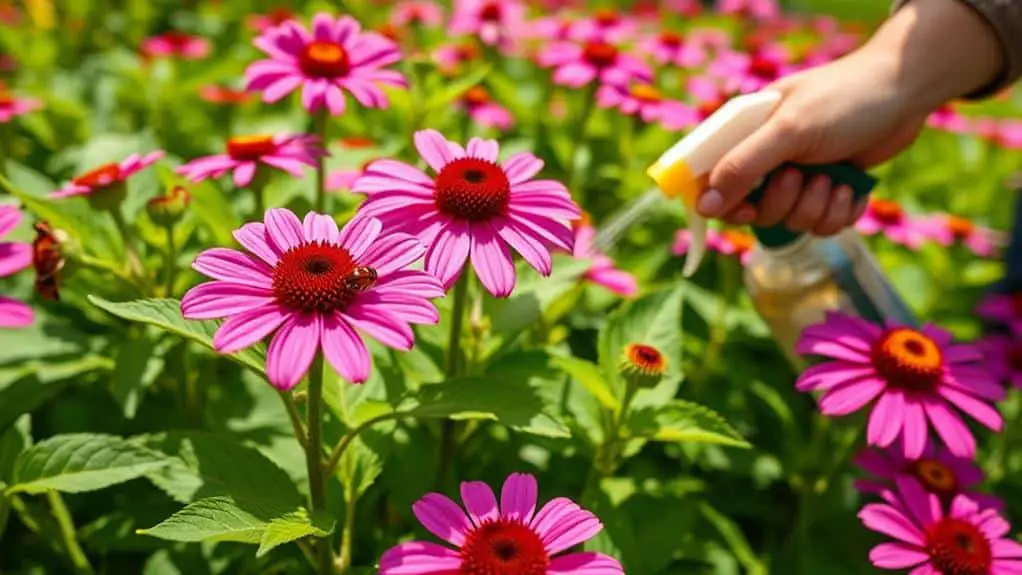
Pentas flowers, with their vibrant hues, can fall prey to pests and diseases that affect their longevity and beauty.
To guarantee your blooms last, regularly inspect your plants for common pests like aphids and spider mites. I recommend using organic pest control options, such as neem oil or insecticidal soap, which effectively treat infestations without harming beneficial insects.
Good air circulation around your Pentas reduces the risk of fungal diseases, especially in wet conditions that might cause root rot. Promptly remove and dispose of any infected plant material to prevent disease spread.
Implement a routine monitoring schedule during the growing season to catch early signs of pest problems. This way, you can intervene quickly and enjoy healthier, longer-lasting blooms.
Propagation Methods
To guarantee your garden is always brimming with vibrant Pentas flowers, knowing effective propagation methods is essential.
One of the best ways to propagate Pentas lanceolata is through softwood cuttings taken in spring. Here's how you can do it:
- Dip the terminal wood cuttings in rooting hormone.
- Place them in a pre-moistened soilless medium.
- Make sure they receive regular moisture and shade.
For seed propagation, start seeds indoors 7-9 weeks before the last frost date.
Don't forget to harden off the seedlings for at least a week before planting them outside.
Leaf cuttings are also an option, but softwood cuttings typically yield faster results.
With these methods, your garden will be bursting with beautiful blooms in no time!
Frequently Asked Questions
How Do You Keep Pentas Blooming?
To keep pentas blooming, I focus on proper pentas care by ensuring they get ideal sunlight, use effective watering techniques, and deadhead regularly. I also apply balanced fertilizer and monitor for pests to maintain vibrant, healthy blooms.
How Do You Prolong Blooming?
To prolong blooming, I guarantee my penta varieties get at least 6 hours of sunlight. I use proper watering techniques to maintain soil moisture without overwatering. Consistent care helps my pentas thrive and bloom beautifully.
What Is the Best Fertilizer for Pentas?
I recommend using a balanced liquid fertilizer with equal parts nitrogen, phosphorus, and potassium. Apply every 4 to 6 weeks. Ascertain your pentas get well-draining soil, moderate watering frequency, and full sunlight for the best results.
Do Pentas Need to Be Deadheaded?
Yes, pentas need deadheading. I use deadheading techniques like cutting below wilted blooms during seasonal care. It encourages new growth and vibrant flowers. Also, proper pest management keeps them healthy and looking their best.
Conclusion
With these tips, you'll have beautiful, long-lasting blooms on your pentas flowers. Remember to give them plenty of sunlight and keep the soil just right—moist but not soggy. Don't forget to fertilize regularly and deadhead spent flowers to keep them blooming. Keep an eye out for pests and diseases, and make sure your plants have good air circulation. With a little care and attention, your pentas will thrive, and you'll enjoy their vibrant blooms all season long.

